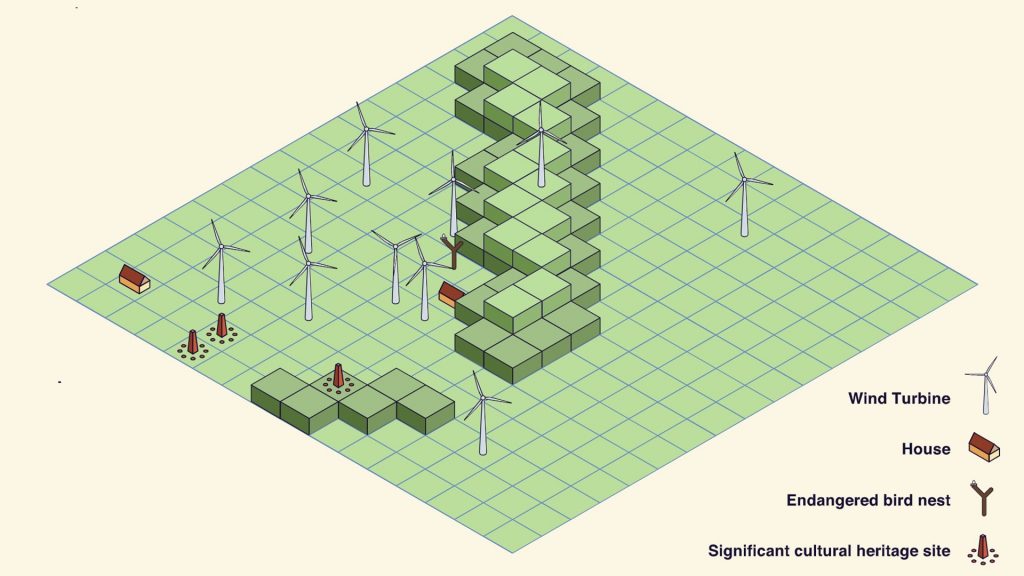Topic
Why is wind a renewable energy resource?
For thousands of years, people around the world have used the force of the wind to lift, push, and pound. With the invention of devices that can turn motion into voltage, wind is a power source that will never run low no matter how often we use it.
Video
A short 3.5 minute video explaining the topic for students.
Why is wind a renewable energy resource?
A fun introduction to how we use wind to generate renewable energy.
Use this video in your lesson or share directly with your students.
Digital Activities
Digital interactive activities can be used in your classroom in conjunction with the video, or independently.
Q&A
This interactive Q&A is designed to quiz students on what they have learned after watching the video.
This is a digital version of the multiple choice PDF worksheet below.
The great windfarm challenge
A game where students decide where to place 10 wind turbines. They explore ways to maximise electricity production while balancing social, environmental, and cultural impacts.
Demonstrates the complexities of designing a wind farm in a real world context.
Worksheets and Classroom Activities
Topic PDF worksheets can be used in your classroom either in conjunction with the video or independently.
Q&A
This Q&A worksheet is designed to quiz students on what they have learned after watching the video.
This is a PDF version of the digital interactive found above.
Making a mini turbine (advanced)
This worksheet has all the instructions on how to run an independent, practical classroom activity, where students design and build the best wind turbine blade in a fun classroom competition.
Teacher Resources
Teacher notes & worksheet answers
By using the resources available for this topic, your students have the opportunity to learn:
- Wind can be used to turn a turbine to grind grain, pump water, and generate electricity
- Wind turbines generate electricity by turning magnets to generate a magnetic field in a dynamo
- Wind is a renewable energy source and has less downsides than non-renewable energy sources
- A convection current is caused by the sun heating the earth, causing particles of air to move
- Different types of wind turbine technology
This PDF includes:
- Video summary
- Literacy links
- Research tasks
- Curriculum links
- Worksheet answers
Curriculum Mapping
Lower Secondary topics are designed for Australian grade 7 and 8 students and are aligned to Australian curriculums.
Australian Curriculum Science, year 8
Overview. View link
Energy appears in different forms, including movement (kinetic energy), heat and potential energy, and energy transformations and transfers cause change within systems (ACSSU155). View link
Solutions to contemporary issues that are found using science and technology, may impact on other areas of society and may involve ethical considerations (ACSHE135). View link
Cross curricular priorities: Sustainability.
General capabilities: Numeracy, Literacy, Ethical understanding.
NSW Curriculum Science, stages 3 and 4
Overview. View link
Discusses how scientific understanding and technological developments have contributed to finding solutions to problems involving energy transfers and transformations (SC4-11PW).
Appreciates the importance of science in their lives and the role of scientific inquiry in increasing understanding of the world around them (SC4-1VA).
Cross curricular priorities: Sustainability.
General capabilities: Numeracy, Literacy.
Victorian Curriculum Science, levels 7 and 8
Overview. View link
Energy appears in different forms including movement (kinetic energy), heat, light, chemical energy and potential energy; devices can change energy from one form to another (VCSSU104) . View link
Science and technology contribute to finding solutions to a range of contemporary issues; these solutions may impact on other areas of society and involve ethical considerations (VCSSU090). View link
Some of Earth’s resources are renewable, but others are non-renewable (VCSSU100). View link
Cross curricular priorities: Sustainability.
General capabilities: Numeracy, Literacy.

